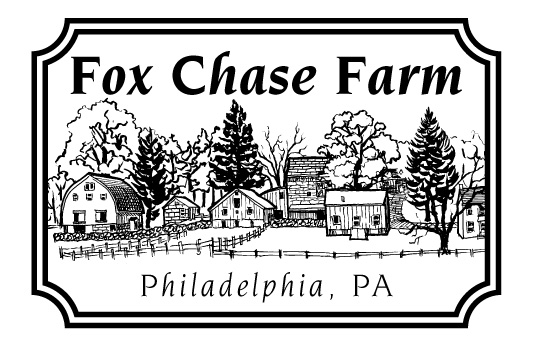It is somewhat of a miracle that Fox Chase Farm has survived. It reflects the changing nature of the countryside and indeed our country.
Historical Highlights — find out more about the periods indicated. This chronology reflects current information. Research is ongoing.
1683 - 1692 — A Homestead is Established
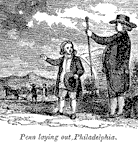
William Penn sold the first 500 acres of what is now known as Fox Chase Farm to William Stanley, of London. It was initially called “Mount Stanley.”
1683
The land, 500 acres, was sold by William Penn to William Stanley, of London. He named the site “Mount Stanley”.
1690
Stanley died in debt and his property was purchased by Peter Baynton, a friend in Philadelphia.
1692
Peter Baynton divided the parcel into two 250 acre tracts on each side of the Pennypack Creek. He sold the land south of the creek to Edward McVeagh/McVaugh, a farmer and carpenter for Thomas Holmes, the surveyor for William Penn. The McVeagh family retained ownership of the property for over 100 years and established a homestead in the area of the present farm buildings.
1821 - 1863 — The Wistar Years
1821
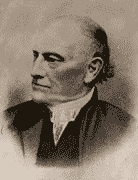
As Thomas Wistar II (above) traveled out west, sent by President Grant to get fair treatment for the Indians after the Civil War, his son Thomas Wistar III managed the farm. The Wistar family has proved to be the most important owners of the property from a historical point of view. They established the property, known as Stanley, as a working, self-supporting farm.
Thomas Wistar, of the prominent Quaker family, purchased 100 plus acres from the estate of the McVeagh family and built a large, central-entrance stone mansion known as “Stanley” for his son Thomas Wistar Jr. and his bride Elizabeth Buckley Morris. This building is now known as “The Manor House”. Thomas Wistar Jr. built a second house for his son Thomas III and his wife Priscilla, ca. 1849. This is the present white farmhouse. One beam of this house is clearly earlier than 1849, so it is likely that there was some structure there, and what we see is something newly built and expended ca.1840s. The large Penn bank barn (Hay Barn which burned in 1997) pre-existed 1821. The Old Sheep barn was built ca. 1832.
Thomas Wistar Jr. was active in politics. During the administration of President Grant, he was involved in Indian affairs. He spent a lot of time out west (trying to get fair treatment for the Indians after the Civil War), and Thomas Wistar III worked the farm. He established the property as a working, self-supporting farm. When Thomas III died prematurely in1863, his farm implements and fixtures were sold at auction. After the death of his son, Thomas Wistar Jr. lived out his life at “Stanley”.
1876-1901 — Multiple Owners, but Development is Averted
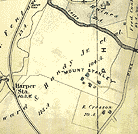
Detail of 1897 map showing “Mount Stanley”, under ownership of Ed. S. Handy Jr., et. al.
1876
Thomas Wistar Jr.’s will requested sale of his property and 102 acre farm to his neighbor Charles Linton. Linton then leased it to his son until 1888.
1888 – 1901
Between 1888 and 1901 the farmstead had four owners who appear to be land developers interested in dividing the farm into lots suitable for development. Fortunately, this did not happen.
1901-1917 — The Manor House gets a new look

Fox Chase Farm well house was probably used for cooling milk. Photo courtesy of Susan L. Ruff
1901
Property (102 plus acres) purchased by Friends Asylum for the Insane who used the site for agricultural purposes and for the treatment of women patients. They kept the farm in tip-top shape. All the latest farming methods were used. Each cow even had a supply of fresh water. Milk production at the time was well above average. During this time, the Manor House was renovated and dormers were added. The attached well house was probably used for cooling milk.
1917
George H. Lorimer, editor of The Saturday Evening Post and Chairman of Curtis Publishing Company bought the property. Lorimer also founded Lorimer Park in Abington Township with some of his holdings. At this time the farm was used as a gentleman’s farm and maintained by a farm manager, Mr. Harry Larr and his family. They lived in the current farmer’s house. The Manor House was furnished and maintained even though the Lorimers did not live there, with a library in the right front room and a formal dining room in the left front room.
1939-1969 — The Butler years
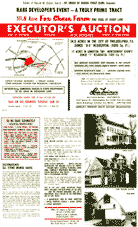
Auction Brochure for the Estate of Harold M. Butler
1939
Harold Butler purchased the property and also used it as a gentleman’s farm. He had two resident managers. Frank Reed left in 1955. Erwin Glancy lived on the farm with his family and maintained it until 1983. During that time, they kept Hereford and Angus cattle and there were sheep in the Old Sheep Barn. Buildings were constructed of Belgian blocks scavenged from demolition sites in Philadelphia. Also, the current Pig Barn, a large barn of about three stories, was built in the 1940s. This barn is a unique construction with 18 rafters of bentwood laminated timbers. Mr. Glancy claimed that some of the pine planks used in the animal stalls came from the 1940 Republican Convention in Philadelphia.
1969
Estate of Harold Butler sold the site (83 acres) to Tri-Pak Development Corporation of New York. The Glancy family continued maintaining the farm.
1972-1980 — From private hands to public lands
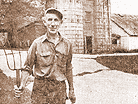
Photograph of Erwin Glancy, caretaker of Fox Chase Farm since the Butler years. Photo, taken by William Steinmetz, appeared in the Philadelphia Inquirer on May 4, 1981.
1972
Property was purchased by Larwin Multihousing Corporation (81.6 acres). Plans to build 884 garden type apartments were stalled due to zoning restrictions. Some foundations for 850 townhouses were built in the field behind the Manor House.
1975
City of Philadelphia purchases 30.5 acres located in Philadelphia for $950,000. These are the front fields between Pine Road and the white farmhouse.
1980
The 81.6 acres is purchased for public land. Following is a breakdown of the purchase:
- $ 500,000 Federal money for entire tract
- 750,000 Federal contingency money
- 1,950,000 City of Philadelphia (50 acres)
- 7,000 Abington Township (21.6 acres)
- 70,000 Montgomery County (10 Acres)
1981 - 1994 — Opportunities to visit and learn

Annual Sheep Shearing Day festival has been held at the farm since 1995, along with Applefest, Family Farm Day, and Maple Sugar Day.
1981
The farm is leased to Saul Agricultural School. Resident farmer, Bill McFadden, is hired by the Philadelphia School District.
1987
Farm festivals begin. The farm is open to the public four times each year for seasonal festivals.
1990
Friends of Fox Chase Farm, a community support group, is founded.
1993
Summer tours and crafts on Sundays begin. This gives the public another opportunity to visit the farm.
1994
Maintenance of the farm is transferred to Abraham Lincoln High School as part of their Horticulture and Environmental Science programs. Classes and tours for school groups begin in September.
1997 - 2001 — The destruction and rebuilding
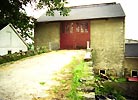
Barn before it was damaged by the 1997 fire. Photo courtesy of Ken Rudolph.
1997
Historic Penn bank barn (Hay Barn) burns. All historic wood materials, roofing, timbers, windows, doors, were severely damaged. The adjacent sheep barn was also severely damaged. Fortunately, all the animals were saved by the resident farmers. This fire had long-reaching effects, impacting on the 16,000 to 18,000 people who come to the farm yearly for educational purposes, festivals, and tours. With the cooperation and support of the Fairmount Park Commission and the Philadelphia School District, the Friends of Fox Chase Farm begin community awareness and fund raising activities to help restore the barn.
2000
The Philadelphia School District, with some financial assistance from the Fairmount Park Commission and it’s NLREEP grant, provides funding for rehabilitation of the barn. Work on the barn proceeds and a new educational building is added to the site in front of the original barn. The exterior of the barn conforms to its original appearance. The interior utilizes 21st century construction technology.
2001
Dedication of new barn October 20, 2001.
2005 - Present
The Friends of Fox Chase Farm (FFCF) retained Historic Preservation Specialist Jean Wolf to research the history of the farm. In 2005, Fox Chase Farm was placed on the National Register of Historic Places. You can see it’s location in the National Register Digital Assets (under the name “Stanley”). In 2018 FFCF again retained Jean Wolf to prepare an application for a PA Historical Marker honoring Thomas Wister II for his exceptional efforts on behalf of the Indians. The application was approved in March 2019.
Fox Chase Farm continues to offer educational opportunities for children and adults through the school program and public events.
